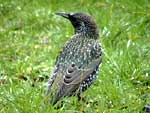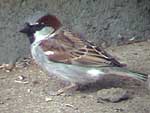Natural Enemies of Wild Birds
These non-native birds, the European Starling and House Sparrow (formerly known as English Sparrow), are introduced species from Europe. If you want to read more about them and their history, click on their respective names above. Since their arrival, they have multiplied at tremendous rates extending their range from sea to shining sea.
In an article entitled Build A Birdhouse, the Oklahoma Department of Wildlife Conservation says,
Ubiquitous English sparrows and starlings can prove exasperating to those seeking to attract native species of bird houses. Only by persistent harassment can these pests be eliminated. Often sparrows can be trapped inside the houses during the night. But remember: any relaxation of the war against starlings and sparrows will find them re-established. Starlings usually will not inhabit boxes within 10 feet of the ground.
Purple Martin Predation
To help with the predation of the Purple Martin species, The Purple Martin Society sells a Starling/House Sparrow Nest-box Trap for European Starlings and House Sparrows. This trap house design is excellent and easy to use. Both of these predators are readily attracted to this house.
Managing & Controlling House Sparrows
The North American Bluebird Society has a very informative paper entitled Fact Sheet: House Sparrow Control. Another Bluebird Society, Sialis, has an excellent page on active and passive ways of Managing House Sparrows.
Controlling Other Predators
Mount your bird houses on metal poles with squirrel guards or other baffles to keep cats, raccoons, snakes, and rodents from climbing up the pole into the nest. If you have squirrels, make sure you place the nest boxes beyond the jumping range of these predators.


